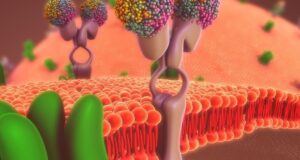
Ever had an itchy nose or, worse, an unreachable spot on your back that drives you mad? Now imagine an itch that refuses to go away, no matter how hard or long you scratch. That persistent itch, or pruritus, may actually be one of the skin’s first lines of defense against harmful invaders, according to neuroimmunologist Juan Inclan-Rico of the University of Pennsylvania.
“It’s inconvenient, it’s annoying, but sensations like pain and itch are crucial. They’re ever-present, especially when it comes to skin infections,” says Inclan-Rico, a postdoctoral researcher in the Herbert Lab at Penn’s School of Veterinary Medicine, who has been exploring what he calls “sensory immunity,” the idea that “if you can feel it, you can react to it.” Itch, he explains, is the body’s way of detecting threats such as skin infections before they can take hold.
But in a recent paper published in Nature Immunology, De’Broski Herbert, professor of pathobiology at Penn Vet, and his team flipped that theory on its head. They shed light on how a parasitic worm, Schistosoma mansoni, can sneak into the human body by evading this very defense mechanism, bypassing the itch response entirely. And while there are prophylactic therapeutics for those who may encounter S. mansoni, options for treating someone who has unknowingly been exposed are relatively scant, and these research findings pave the way for addressing this concern.
These blood flukes, which are among the most prevalent parasites in humans, infecting nearly 250 million people, have seemingly evolved to block the itch, making it easier for them to enter the body undetected. So, we wanted to figure out how they do it. What are the molecular mechanisms underlying how they turn off such an essential sensory alarm? And what can this teach us about the sensory apparatus that drives us to scratch a pesky itch?”
Inclan-Rico, postdoctoral researcher in the Herbert Lab at Penn’s School of Veterinary Medicine
Not all reactions are equal
Inclan-Rico says that the research really began when his project revealed that certain strains of mice were more susceptible to infection of S. mansoni. “Specifically, some of the mice had a higher number of parasites successfully traversing throughout body following skin penetration.”
Heather Rossi, a senior research investigator in the Herbert lab and co-author on the study, says that this motivated the team to investigate the neuronal activity at play, with special attention paid to MrgprA3 neurons, which are commonly associated with immunity and itchiness.
They then looked at how a “cousin” of S. mansoni that’s typically found in avian species but has been shown to cause swimmer’s itch in humans, and they found a stark difference between the reaction or lack of it within the mice.
“While avian schistosomes triggered a strong itch response in the skin, S. mansoni was unable to induce this reaction,” Rossi says. “What’s more, when we introduced chloroquine-;an anti-malarial drug that’s known to cause pruritus by interacting with MrgprA3-;to the mice treated with S. mansoni antigens, we found that itching was blocked almost entirely.”
A closer look
To further investigate the biochemistry involved in S. mansoni’s workaround for skating past MrgprA3 neurons, the researchers employed a three-legged strategy: Using light to genetically activate neurons on ear skin prior to infection, administering chloroquine, and genetically reducing the population of MrgprA3 neurons in the mice.
“Turns out that activating these neurons blocks the entry,” Inclan-Rico says. “It creates an inflammatory environment, we think, within the skin that prevents the entry and dissemination of the parasites, which is particularly cool.”
Members of the Herbert lab, (Left to right): Ulrich Femoe, Heather Rossi, Adriana Stephenson, Evonne Jean, Annabel Ferguson, De’Broski Herbert, Juan Inclan Rico, Heidi Winters, Camila Napuri, Li-Yin Hung, Olufemi Akinkuotu. (Credit: Adriana Stephenson)
The Herbert lab has been studying parasites that enter the skin, migrate through the layers of connective tissue all the way through until they find a blood vessel, and chart a course towards the lung. There they molt into another larval stage and then use the liver and portal vein to make their way to the intestines as adults where they lay eggs, leading to characteristic symptoms in humans like abdominal swelling, fever, and pain.
“So, as you may imagine, if there are fewer parasites entering the body during initial infection, and also fewer parasites making their way into the lungs,” Inclan-Rico says. “This suggests two things: That the activation of these neurons is blocking the entry of the parasites and it’s also inhibiting their dissemination through the body.” The researchers also found that the mice that had MrgprA3 ablation saw an increased amount of lung parasite infection.
Subcellular crosstalk
Armed with the knowledge that MrgprA3 neurons were involved in blocking the parasites, the team hypothesized that there may be crosstalk between these cells and immune cells, so they began investigating the relationship between these two classes.
“When we activated MrgprA3, it increased the number of macrophages in the skin,” Inclan-Rico says. “These are the white blood cells that typically come in and gobble up infectious elements, and so, when we depleted the macrophages, we saw that this was in fact a causal relationship, that the neurons were functionally linked to the macrophage response because without them the worm infection wasn’t blocked at all.”
Next, the Herbert team sought to find the specific signaling molecules involved and discovered that downstream of MrgprA3 activation the neuropeptide CGRP was released, demonstrating that this neuropeptide plays a key role in neuron-immune cell communication.
“CGRP acts like a messenger between neurons and macrophages,” Inclan-Rico says, “and this signaling triggers the activation of immune cells at the site of infection, which helps contain the parasite.”
However, CGRP wasn’t acting alone as the team found that the nuclear protein IL-33, typically known as an alarm signal released by damaged cells, played a surprising, significant role. When they examined macrophages, they discovered that IL-33 was not just being reduced but was instead acting within the cell nucleus.
“Up until now, people just thought that IL-33 was a nuclear protein, but we didn’t know exactly what it was doing in there. Its role was more thought to be as a secreted factor, either as a consequence of cell death or potentially from immune cells secreting it directly,” Rossi says. “But we did a number of experiments to prove that, in fact, IL-33 in macrophages controls the accessibility of DNA, essentially opening DNA’s tight packaging material and allowing pro-inflammatory cytokines like TNF to be expressed.”
This pro-inflammatory environment is critical for forming a protective barrier that prevents the parasite from advancing farther into the body.
“It’s a two-step process,” Inclan-Rico says. “First, MrgprA3 neurons release CGRP, which signals into macrophages. Then, IL-33 held within the macrophages’ nuclei is greatly reduced, which enhances the inflammatory response and helps block the parasite’s entry.”
Interestingly, they also found that when IL-33 was genetically deleted from macrophages, the protective response induced by itchy neurons was lost.
“This tells us that the neurons are orchestrating this whole defense, but they need the macrophages-;and specifically IL-33 in those macrophages-;to mount a full immune response,” Herbert says.
Looking ahead, the Herbert lab plans to dive deeper into understanding the mechanisms behind this neuron-immune communication.
“We’re really interested in identifying the molecules that parasites use to suppress the neurons and whether we can harness that knowledge to block parasite entry more effectively,” Herbert says. They also hope to identify other molecules, beyond CGRP and IL-33, that are involved in this signaling pathway.
“If we can pinpoint the exact components that parasites are targeting to evade the itch response, we could develop new therapeutic approaches that not only treat parasitic infections but potentially offer relief for other itch-related conditions like eczema or psoriasis,” Herbert says.
Source:
Journal reference:
Inclan-Rico, J. M., et al. (2024). MrgprA3 neurons drive cutaneous immunity against helminths through selective control of myeloid-derived IL-33. Nature Immunology. doi.org/10.1038/s41590-024-01982-y.




